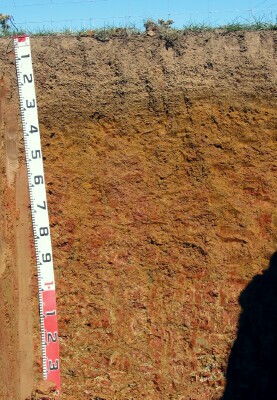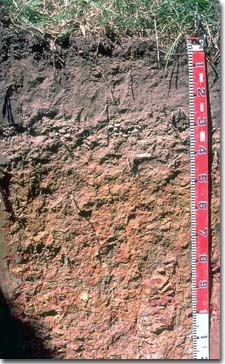Victorian Horticulture Soils - Chromosols
Back to: Victorian Horticulture Soils
Chromosols (Australian Soil Classification) display strong texture contrast between the surface (A) horizons and the clay subsoil (B) horizons. The subsoil is also not strongly acid, i.e. pH is greater than 5.4 in water, and non-sodic (at least in the upper horizons). There may be a bleached subsurface (A2) horizon overlying the clay subsoil.
Distribution
| Chromosols are common in a range of landscapes throughout south-west Victoria, particularly in the Glenelg-Hopkins catchment management region. Brown Chromosols are most common, with Yellow Chromosols occurring in lower parts of the landscape. Soil pit site CRC2 is an example of a Chromosol near Hamilton. |  |
| In the Corangamite region, Chromosols are most common on sedimentary plains and rises in the southern and western parts. They also occur in some areas on basalt and volcanic ash/scoria deposits, where they often have dark coloured (dark grey to black) subsoils. |  |
| In north-east Victoria, Chromosols are most common west of Wodonga. The pattern of Chromosol distribution seems to be related to lower rainfall areas, relative to the distribution of other more acidic soils such as Kurosols and acidic Dermosols. Red Chromosols are usually found on the more freely draining landforms e.g. prior stream ridges and the older or slightly higher terraces and in hilly areas. Soil pit site NE40 is an example of a Red Chromosol near Rutherglen. |  |
In central Victoria, Chromosols occur widely in the uplands, mostly on granitic rocks on and near major catchment boundaries as well as on alluvial terraces. They can also occur on basalts near the main divide. In some areas, the surface horizons contain abundant quartz.
| Brown Chromosols are extensive on the Mornington Peninsula where they are usually associated with viticulture. In areas with deeper lighter-textured surface horizons they can also be suited to vegetable cropping. Soil Pit Site GP22 is an example of a Brown Chromosol used for celery cropping near Cranbourne. |  |
Management Considerations
Surface horizons
Management strategies for all soils should include: increasing organic matter levels in the surface soil, minimising the degradation of soil aggregates and porosity, promoting the development of stable biopores, improving the calcium status of the cation exchange complex (particularly when sodium is a significant part), and breaking up any hardpans. Less frequent tillage, using less aggressive implements and working the soil at its optimum moisture content, can all assist in maintaining soil aggregation and porosity, as well as reducing organic matter breakdown.
Organic matter is important for maintaining surface soil aggregations and preventing slaking. Organic matter levels will build up under pasture but will decline if cultivation takes place. Practices such as residue retention, minimum tillage and including pasture rotations can be utilised to build organic matter. The soil surface tends to be hardsetting which is exacerbated through loss of organic matter associated with cultivation, particularly when silt and fine sand contents are high.
In some landscapes, quartz and ironstone gravel content in surface horizons can be significant. This will reduce water availability to shallow-rooted species and provide some restriction to plant roots.
The surface horizons can be strongly acid and levels of exchangeable aluminium should be monitored. A pH/aluminium test on a bulked sample (taken from across the paddock) would be most appropriate to determine if lime is needed to raise soil pH. Other factors need to be considered though before lime is recommended (e.g. type of crop grown, method of application, local trial responses, soil surface structure and likely cost/benefit). The upper subsoil is not strongly acid, so should present few issues for aluminium-sensitive species if pH in the surface horizons is managed appropriately.
Although these soils are non-sodic in the upper part of the soil profile, the subsurface (A2) horizon can occasionally disperse after remoulding. If this is the case, then cultivation of this horizon should be avoided if it is in a moist to wet condition. Such disturbance is likely to result in a more restrictive cultivation pan developing.
Subsoil horizons
Texture contrast soils usually have restricted root and water movement into the clay rich subsoils. However, Chromosols are non-sodic, at least in the upper subsoil, and tend to be better structured and drained than Sodosols. The upper subsoil is non-sodic and usually well structured, with larger aggregates parting to many fine polyhedral shaped peds. This provides suitable conditions for root and water movement. Reddish colour and lack of mottling in the upper subsoil also indicates that drainage and aeration is good. Waterlogging may still occur after heavy rains, particularly in lower landscape positions.


